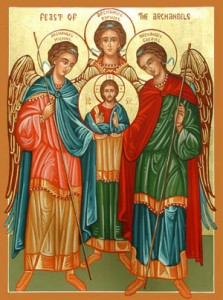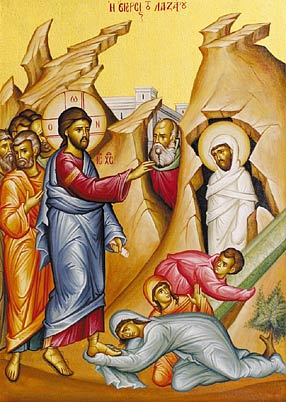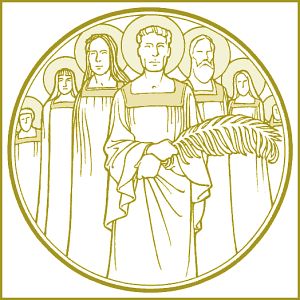====================
This sermon was preached on St. Michael and All Angels Day, September 29, 2013, at St. Paul’s Episcopal Church, Medina, Ohio, where Fr. Funston is rector.
(The Episcopal Lectionary, Michaelmas: Genesis 28:10-17; Revelation 12:7-12; Psalm 103; and John 1:47-51. These lessons can be read at The Lectionary Page.)
====================
 We are stepping out of the “common of time,” away from the progression of lessons assigned for the Sundays of Ordinary Time, and instead celebrating the Feast of Michaelmas, known variously as the Feast of Saint Michael the Archangel or as the Feast of Saints Michael, Gabriel, Uriel, and Raphael, or as the Feast of the Archangels, or as the Feast of Saint Michael and All Angels (the latter being the preferred Anglican name for this commemoration). The only reason we are doing so is a personal conceit of your rector; Michaelmas, the 29th of September, just happens to be my birthday. Today I am celebrating the 30th anniversary of my twenty-eleventh birthday. I’ll get back to that in a moment, but first . . . a word about Michaelmas.
We are stepping out of the “common of time,” away from the progression of lessons assigned for the Sundays of Ordinary Time, and instead celebrating the Feast of Michaelmas, known variously as the Feast of Saint Michael the Archangel or as the Feast of Saints Michael, Gabriel, Uriel, and Raphael, or as the Feast of the Archangels, or as the Feast of Saint Michael and All Angels (the latter being the preferred Anglican name for this commemoration). The only reason we are doing so is a personal conceit of your rector; Michaelmas, the 29th of September, just happens to be my birthday. Today I am celebrating the 30th anniversary of my twenty-eleventh birthday. I’ll get back to that in a moment, but first . . . a word about Michaelmas.
It shouldn’t surprise any of us that on, St. Michael and All Angels Day, we are treated to three very familiar stories of angels in Holy Scripture: first, the story of “Jacob’s ladder;” second, the story of the war in heaven in which Michael, leading the “good” angels, beats “the dragon” (named “the Devil or Satan”) and his “bad” angels; and finally, the gospel story of Jesus telling Nathanael that he will see something like Jacob’s ladder, “ascending and descending upon the Son of Man.”
We know what angels are, or at least we think we do. They are a separate order of creation, beings of spiritual energy who interact with human beings as the servants and often as the messengers of God. The English word angel derives from the Latin angelus which in turn is the romanization of the ancient ángelos which means “messenger” or “envoy.” In the Hebrew of the Old Testament, we find the terms mal’ak elohim (“messenger of God”), mal’ak YHWH (“messenger of the Lord”), bene elohim (“sons of God”) and haqqodesim (“holy ones”) translated into English as angels. The first of these, mal’ak elohim, is what we find in today’s Genesis passage. In addition, there are specific kinds of angels identified in the Hebrew Scriptures. There are the Cherubim – one of whom is placed with a flaming sword to guard the gateway to the Garden of Eden in Genesis 3 and who are said to flank or support God’s throne as, for example, in Hezekiah’s prayer in the book of the Prophet Isaiah (ch. 37); the Cherubs are apparently not cute, little, chubby baby angels! And there are the Seraphim – whom Isaiah describes as having “six wings: with two they covered their faces, and with two they covered their feet, and with two they flew,” and who sing God’s praises in the heavenly throne room.
We know the personal names of some of the angels, particularly the archangels – Gabriel, who is named in the Book of Daniel and identified in the Gospel of Luke as the angel of the Annunciation; Raphael, who is identified as a companion and advisor to Tobias in the apocryphal Book of Tobit; Uriel, who was sent to test the prophet Ezra according to the apocryphal Second Book of Esdras; and Michael, who is the leader of God’s angel army in the story of Revelation today.
We know that human beings, when they die, do not become angels . . . although lots of people say things like that in order to comfort the bereaved who have lost loved ones. Angels, as I said, are a separate order of creation, beings of immense spiritual energy. If the Book of Job is correct, they were created before the physical world: in questioning Job, God asks him if he was there when the foundations of the earth were put in place, “when the morning stars sang together and all the heavenly beings shouted for joy?” (38:7; the term here is bene elohim, sons of God.)
So . . . we know a lot about angels, but why do we venerate them on this particular day? And what can we learn from them? The first question is easy to answer: the date commemorates the dedication of the Sanctuary of St. Michael Archangel built on Monte Gargano in Italy in 493 a.d. in honor of an apparition of the archangel a few years before. The second question is not so easy.
What I think we learn from angels is conscience. Whenever I hear the word “angels,” to be very honest, my first thought is not of their religious history or meaning, but of the conclusion of Abraham Lincoln’s first inaugural address given on March 4, 1861, just two weeks after Jefferson Davis had been inaugurated as president of the Confederacy. Referring to that secession and the potential of war to preserve the Union, finished his speech saying:
We are not enemies, but friends. We must not be enemies. Though passion may have strained it must not break our bonds of affection. The mystic chords of memory, stretching from every battlefield and patriot grave to every living heart and hearthstone all over this broad land, will yet swell the chorus of the Union, when again touched, as surely they will be, by the better angels of our nature.
I love that turn of phrase, “the better angels of our nature.” I’m not the least bit sure what Mr. Lincoln meant by the phrase, but it has always appealed to me. A few years ago, a Harvard psychologist named Steven Pinker used it as the title of a book in which he named four of these “better angels:”
- Empathy, which “prompts us to feel the pain of others and to align their interests with our own”
- Self-control, which “allows us to anticipate the consequences of acting on our impulses” and thus to regulate those impulses
- Moral sense, which “sanctifies a set of norms and taboos that govern the interactions among people”
- Reason, which “allows us to extract ourselves from our parochial vantage points.”
These are all, to my way of thinking, gifts of God. In a sense, they are a modern rendition of what St. Paul called the “fruit of the Spirit,” although Paul listed nine attributes: love, joy, peace, forbearance, kindness, goodness, faithfulness, gentleness and self-control. (Galatians 5:22-23) Or of those gifts of the Holy Spirit listed by Isaiah: wisdom, understanding, counsel, fortitude, knowledge, piety, and fear of the Lord. It is through these fruits and gifts that human conscience is informed and moral judgment enlightened, and conscience, as Thomas Merton said, “is the light by which we interpret the will of God in our own lives.” (No Man Is an Island)
Some of you may be familiar with the Henry Fonda film from the 1940s entitled The Ox-Bow Incident. It’s based on a novel of the same name by the Nevada writer Walter Van Tilburg Clark. In the story, the narrator Art Croft is one of two men who drift into a Nevada ranching town and end up becoming part of a posse that turns into a lynch mob. They end up hanging, without a trial, three men who may or may not actually be guilty of the crimes they are accused of — cattle rustling and murder. Reflecting on what has happened, Art Croft asks, “If we can touch God at all, where do we touch him save in the conscience?” If the angels are the messengers of God, perhaps our conscience is the means through which the “better angels of our nature” communicate God’s will to us. As Theologian Peter Kreeft explains, the conscience as “the voice of God in the soul.”
Along those lines, in a Michaelmas sermon preached a few years ago, the Very Rev. John Hall, Dean of Westminster Abbey, said this:
We can and should then think of God speaking directly to us, out of his love and care for us as individuals. However we must understand God’s presence with us as a reality inseparable from that of God’s presence among us. Through our fellowship in the Church, Christ’s Body, God informs our conscience through his Word and feeds our soul through the sacraments, drawing us together as Christians into unity with each other and with himself. If we try to go it alone as Christians, we run great risks of going astray. The Church understands the work and role of the angels as assisting in mediating the presence of God with us and amongst us. (29 September 2010)
I don’t think I can learn much from angels as mighty beings standing guard at the entrance to Eden, or as warriors fighting Satan and casting him out of heaven, or as singers in the heavenly choir, or as the pillars and supports of God’s throne. But as the prompters and prickers of my conscience, as the “better angels” of empathy, moral sense, self-control, and reason, as the communicators of the gifts and fruits of the Spirit, as mediators of God’s presence in the Church, I can learn a great deal from them.
The Psalmist, in our gradual this morning, declared that God’s righteousness and merciful goodness endure forever “on those who keep his covenant and remember his commandments and do them.” It is these “better angels” who keep that memory alive in our consciences and to them, and to the God whose presence they mediate within us individually and among us corporately, we can turn for answers to life’s challenges.
So . . . as I said, it’s my birthday. Today, and for the next decade or so, when asked how old I am, I can answer, “Sixty-something.” (A graphic I posted today on my Facebook page says, “I’m not sixty-something. I’m $59.95 plus shipping and handling.”) In any event, a birthday is a time of taking stock, or considering one’s past, one’s actions, the answers one has developed in one’s life, and one’s future.
I mentioned in a conversation with some parishioners last week that when I’d been ten years at St. Francis Parish in Stilwell, Kansas, my congregation last before this one, Evelyn and I came to the conclusion that it was time to leave. One of the people I was talking with asked, “You’ve been here at St. Paul’s for ten years. Is it time to leave?” That’s a birthday sort of question. It’s what might be called “a big question.”
The past six decades, like everyone’s life, has been full of big questions of that sort, to be honest. Whether to study law? Whether to get married? Whether to leave the practice of law? Whether to become a priest? Move to Kansas? Leave Kansas? Accept nomination in an episcopal election? Those are big questions. But sometimes our replies to big questions are little answers, puny responses that put off meeting the real challenges.
A friend recently shared a poem with me, a poem by Dame Edith Louisa Sitwell. I wasn’t familiar with Sitwell so I did some research on her. She was the eldest child of the 4th Baronet of Renishaw Hall, born in 1887. In her twenties, she began publishing poems in the Daily Mirror newspaper. She was six feet tall and habitually wore brocade gowns, gold turbans, and (one biographer said) “a plethora of rings.” Apparently she was given to public feuds with other literary figures. One critic said of her that “wore other people’s bleeding hearts on her own safe sleeve,” and another called her “an eccentric matriarch with a slender grip on reality.” Just my sort of poet! No wonder I liked what she had to say about our responses to life’s questions in a short poem entitled Answers:
I kept my answers small and kept them near;
Big questions bruised my mind but still I let
Small answers be a bulwark to my fear.
The huge abstractions I kept from the light;
Small things I handled and caressed and loved.
I let the stars assume the whole of night.
But the big answers clamoured to be moved
Into my life. Their great audacity
Shouted to be acknowledged and believed.
Even when all small answers build up to
Protection of my spirit, still I hear
Big answers striving for their overthrow.
And all the great conclusions coming near.
I believe the “great conclusions coming near,” the big answers clamoring, the huge abstractions shouting to be acknowledged, are the angels calling each of us to greater ministries, the messengers of God urging us to a more audacious Christian presence in the world.
In a couple of months’ time, our construction project will be done. We’ll have a great new gallery, an expanded parish hall, a great new face presented to the community. When we broke ground here in July, the Old Testament lesson was the same reading from Genesis we hear this morning. I suggested then that this place, this St. Paul’s Episcopal Church located at 317 East Liberty Street in Medina, Ohio, is like Jacob’s Bethel.
It is an awesome place. It is a house of God. It is a gate of heaven. But just like Jacob’s Bethel, it is a place we are bidden to leave; it is a place from which the angels of God bid us go. A church building is meant to be the base from which the people of God go into the world. A church building is meant to be a place of life, a center of ministry, a place of assembly, where God’s people gather to worship, to hear the message of the angels, to celebrate the meaning of life, and to be transformed, and then “burst forth,” back out into the world to share the Good News with, and transform the lives of, others. The angels of God call us individually and corporately to greater ministries, to a more audacious Christian presence in our world.
The answer to that “big question” I was asked is, “No, it’s not time for me to leave St. Paul’s.” But it is time for all of us as St. Paul’s to leave this place, to go out from this new building we are creating, to “burst forth” into the world like Jacob and his offspring, to be “angels,” messengers of God, telling the world the Good News of God in Christ.
Amen.
====================
A request to my readers: I’m trying to build the readership of this blog and I’d very much appreciate your help in doing so. If you find something here that is of value, please share it with others. If you are on Facebook, “like” the posts on your page so others can see them. If you are following me on Twitter, please “retweet” the notices of these meditations. If you have a blog of your own, please include mine in your links (a favor I will gladly reciprocate). Many thanks!
====================
Father Funston is the rector of St. Paul’s Episcopal Church, Medina, Ohio.
 Today, by translation from Thursday, the 1st of November, we celebrate the Feast of All Saints.
Today, by translation from Thursday, the 1st of November, we celebrate the Feast of All Saints. We are stepping out of the “common of time,” away from the progression of lessons assigned for the Sundays of Ordinary Time, and instead celebrating the Feast of Michaelmas, known variously as the Feast of Saint Michael the Archangel or as the Feast of Saints Michael, Gabriel, Uriel, and Raphael, or as the Feast of the Archangels, or as the Feast of Saint Michael and All Angels (the latter being the preferred Anglican name for this commemoration). The only reason we are doing so is a personal conceit of your rector; Michaelmas, the 29th of September, just happens to be my birthday. Today I am celebrating the 30th anniversary of my twenty-eleventh birthday. I’ll get back to that in a moment, but first . . . a word about Michaelmas.
We are stepping out of the “common of time,” away from the progression of lessons assigned for the Sundays of Ordinary Time, and instead celebrating the Feast of Michaelmas, known variously as the Feast of Saint Michael the Archangel or as the Feast of Saints Michael, Gabriel, Uriel, and Raphael, or as the Feast of the Archangels, or as the Feast of Saint Michael and All Angels (the latter being the preferred Anglican name for this commemoration). The only reason we are doing so is a personal conceit of your rector; Michaelmas, the 29th of September, just happens to be my birthday. Today I am celebrating the 30th anniversary of my twenty-eleventh birthday. I’ll get back to that in a moment, but first . . . a word about Michaelmas. Today, following church tradition, we step away from the calendar of Ordinary Time and, instead, commemorate the Feast of All Saints. That festival is specifically held on November 1, but tradition allows us to celebrate the saints also on the Sunday after that date, so here we are.
Today, following church tradition, we step away from the calendar of Ordinary Time and, instead, commemorate the Feast of All Saints. That festival is specifically held on November 1, but tradition allows us to celebrate the saints also on the Sunday after that date, so here we are. I have to admit that I’m not sure how to treat the so-called Second Book of Esdras. Although counted among the apocryphal books, it seems more to me to be what is technically called pseudopigrapha (“false writings”). It is not recognized by any western church; neither the Roman church nor the Protestants recognize it, although it is annexed as part of an appendix to the Vulgate. Only the Greek and Russian Orthodox accept it as Scripture. If I recall correctly, it is actually made up of three different writings all from the 2nd or 3rd Centuries of the Christian era; it’s not “Old Testament”or “Hebrew Scripture”, at all! So what does one do with it? Here it is in the lectionary for All Saints Day for obvious reasons, but what does one do with it?
I have to admit that I’m not sure how to treat the so-called Second Book of Esdras. Although counted among the apocryphal books, it seems more to me to be what is technically called pseudopigrapha (“false writings”). It is not recognized by any western church; neither the Roman church nor the Protestants recognize it, although it is annexed as part of an appendix to the Vulgate. Only the Greek and Russian Orthodox accept it as Scripture. If I recall correctly, it is actually made up of three different writings all from the 2nd or 3rd Centuries of the Christian era; it’s not “Old Testament”or “Hebrew Scripture”, at all! So what does one do with it? Here it is in the lectionary for All Saints Day for obvious reasons, but what does one do with it?

